In animal behavior studies, identifying individual animals is one of the most time-consuming and challenging tasks. New research demonstrates that computers can recognize individual birds, which is difficult or even impossible for the human eye.

There’s a new birder in town
Humans have a hard time identifying individual birds — even for the trained biologist, this is often impossible. The best researchers can reliably manage is to tag birds with different bands and then identify them based on those bands, but that’s time-consuming and invasive for the animals.
Many biological studies are hampered by the lack of ability to distinguish between individuals, but all that might change soon. New research demonstrates that artificial intelligence (AI) can also be trained to recognize individual birds.
“We show that computers can consistently recognise dozens of individual birds, even though we cannot ourselves tell these individuals apart. In doing so, our study provides the means of overcoming one of the greatest limitations in the study of wild birds – reliably recognising individuals.” Said Dr André Ferreira at the Center for Functional and Evolutionary Ecology (CEFE), France, and lead author of the study.
Ferreira and colleagues took a large number of photos of different birds (from camera traps), from various angles. Birds were also wearing individual electronic tags to confirm identification, and the images were fed into computers which used a deep learning algorithm.

The machine learning algorithms rely on an area where AI is already shining: pattern recognition. The computers were able to distinguish between individual birds by looking at patterns on their plumage — something that is extremely confusing to humans but right up an AI’s alley.
So far, the technology has been able to identify specimens from three different species: sociable weavers, great tits, and zebra finches. The model was able to achieve an accuracy of 92.4% for sociable weavers, 90.0% accuracy for great tits, and 87.0% accuracy for zebra finches.
This new technique doesn’t only produce a new cheaper, faster, and non-invasive method of identification, but could also offer new insights in ecology, by opening ways of using AI to look at animal behavior in the wild. The same approach could be applied to studying animal populations — for instance, population estimates often rely on camera traps taking photos of animals, but it’s hard to distinguish individuals.
However, there are also significant limitations. For starters, the AI is only able to re-identify animals it has been shown before and that it has “learned”.
“The model is able to identify birds from new pictures as long as the birds in those pictures are previously known to the models. This means that if new birds join the study population the computer will not be able to identify them.” said Dr André Ferreira.
In addition, it’s not clear how the AI will be affected if birds’ patterns change as they molt or grow — it’s well known that birds’ appearance can change in time.
However, these difficulties could be overcome with larger datasets and even better algorithms, researchers note. The team is currently in the process of gathering this dataset and pushing the limits of the AI further.
“We hope that our work will motivate other researchers to start
exploring the possibility of using deep learning for individual identification in their model species,” the researchers conclude.
Journal Reference: Deep learning-based methods for individual recognition in small birds, Ferreira et al., Liliana R. Silva, Francesco Renna, Hanja B. Brandl, Julien P. Renoult, Damien R. Farinec, Rita Covas et Claire Doutrelant, Methods in Ecology and Evolution, 27 July 2020. DOI: 10.1111/2041-210X.13436






